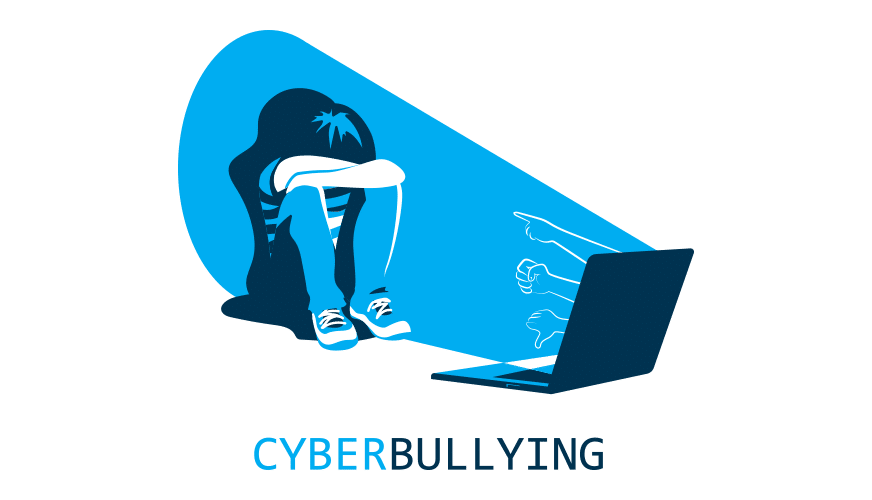University Headquarters (HQ) is an industry-leading, independent educational organization that provides independent college rankings using a proprietary formula to create first class, unbiased rankings. The team at University HQ strives to provide accurate and trustworthy rankings that highlight the best programs.
Bullying is a real problem in our society. While many of us consider bullying a part of schoolyard life that we leave behind in grade school, for many it is a problem that persists through high school and college. Bullies even thrive in the corporate world, where they harass co-workers and employees. The advent of the Internet has provided bullies with an outlet where they can find more victims across a wider field. Cyberbullying also means that victims can be reached anywhere at any time. Thus, those who are bullied may find that there is no true safe haven, unless they are willing to turn off all their networked devices and even telephones, creating a buffer between them and the outside world.
However, some people are working on solutions. Read on if you’re interested in knowing more about how you can identify bullying, prevent it from manifesting, and hopefully keep it from getting out of control.
Resources for Before and After College
What Is Bullying?
Bullying is essentially a power imbalance that is realized through aggressive behaviors. That aggression could be realized through physical acts of abuse or through intimidation tactics that are intended to make the victim feel powerless, weak, and vulnerable. When these aggressive behaviors are repeated and become a pattern, that is when they are considered bullying. Two people might have a single heated exchange without that episode being considered bullying.
When it comes to cyberbullying, that intimidation and aggression can include direct interactions characterized by overt verbal abuse. Cyber-bullies are also known to spread vicious rumors about their victim, create memes that use the victim’s image in unflattering positions, and more. The point is to damage the victim's reputation and destroy their relationships with others. Bullies might also seek out their victim and effectively hunt them online.

Where Can Bullying Happen?
Bullying can happen wherever humans interact. In the days before the internet, bullying was mostly thought to be something that happened in and around schools, or perhaps in the neighborhood. However, we now see that bullies not only practice their abuse in grade school and high school, but for years thereafter. While we may have known this before, it was not recognized as or considered bullying. People are known to experience bullying through the college years and even in corporate workplaces. Bosses might bully their employees and co-workers might seek to intimidate and bully others for a variety of reasons.
Bullying is now seen on the internet. The growth of social media has provided a platform for positive as well as negative connections. Bullies can exploit technical skills to torment their victims. Sometimes they are even able to procure the victim's physical address and phone number if they did not previously have access to it, in order to bring a new level to the torment.
Prevalence of Cyberbullying
Cyberbullying is a relatively novel thing in our world, so the press tends to highlight it. However, this does not mean that it's an anomaly. To the contrary, this phenomenon impacts far more victims than is often assumed.
According to a 2017 study by the National Center for Education Statistics and Bureau of Justice, 15% of students between the ages of 12 and 18 report being bullied via text or online. The Centers for Disease Control and Prevention (CDC) reported similar findings. The CDC's 2017 study showed that 14.9% of students reported being cyberbullied in the previous 12 months.
The Cyberbullying Research Center has reported more dire figures. They aggregated figures from 11 separate studies and found that 27.8% of students have been cyberbullied in the years between 2007 and 2019. The same literature review also found that 16% of students admitted to perpetrating cyberbullying. It can be assumed that this figure is low, as many students may not wish to admit their culpability in this violence.
The CBC's own 2019 report indicated that 20.8% of students aged 10 to 18 had been cyberbullied at some point in their lives. Of that random sample, 17% reported multiple instances of bullying.
Categories and Types of Bullying
Indirect vs. Direct
Direct bullying is the sort we might see portrayed in films and television shows. This variety involves the bully directly assaulting the victim. The attacks might come in a verbal or physical form. Direct cyberbullying might involve a series of abusive emails, text messages, or comments on social media.
Indirect bullying, on the other hand, is more complex and involves other people. The bully might try to smear the victim's reputation with others by spreading lies about them. Cyber-bullies also are known to expose some secret their victim would rather remain hidden. For instance, jilted lovers might share indiscreet photographs of their ex for the purpose of shaming them.
Verbal
Verbal bullying often involves calling someone names that bring attention to certain physical or other characteristics. Bullies love to pick on overweight people, but any physical anomaly is subject to their wrath. Kids with big ears, freckles, red hair, or pimples might be subject to nicknames or other abuse based on their physical attributes. If the victim has done something embarrassing, a bully might use that in their bullying tactics. Particularly clever bullies may devise catchy nicknames that might spread the abuse indirectly through the wider social group.
Race, culture, and religion are also big targets for bullies. They can use these things to spread fear and hatred towards both their intended victim as well as their families and community.
Social/Relational
Social and relational bullying is a form of abuse that seeks to exclude the victim from activities or relationships that they might find beneficial. For instance, a bully might seek to make their victim a pariah whom nobody wishes to work with. Indirect tactics might include sabotaging them in public to undermine their perceived competence or even spreading vicious rumors that poison other's opinions of them.
Though there are many reasons why a bully might choose to exclude their victim from activities, they are likely to feel threatened by the victim. Insecure, yet otherwise capable and competent bullies may wish to eliminate any competition they perceive in their desire to gain social capital.
Physical
Physical bullying includes any physical act of abuse aimed at a single target over time. Though physical abuse can happen at any time, it often follows a period of verbal abuse. Bullies who are stronger than their victims are particularly dangerous because they are known to induce great physical harm. They might kick, punch, or tackle their victims in an effort to assert a sense of power that they truly lack. This can lead to physical and mental trauma, including repeated trips to the hospital, fear of speaking out against them or telling authorities what happened, and an ongoing sense of helplessness that can lead to depression and even suicide.
Physical bullying can also include destruction of personal property. This might include forcing a classmate to drop their books or vandalizing their car, home, or other property. Historically, bullies resorted to burning crosses in the yards of those they feared and hated.
Sexual
Sexual abuse is one of the most pernicious and damaging forms of bullying. Though the word sex is invoked in this terminology, the actions of the bully need not include sex. Rather, the bully's sole purpose is to assert dominance through the weaponization of the victim’s sexuality or gender. The victim's relative attractiveness has nothing whatsoever to do with that violence.
Sexual abuse can even include non-physical aggression. Bullies have been known to shame their victim for their previous or simply perceived sexual behavior, whether true or not. They may even invent claims of sexual behavior to give themselves something to work with. Thus, sexual bullying can involve shame as well as overt physical acts of violence.
Prejudicial
This form of bullying relies on social stereotypes and xenophobia (fear of the other) to fuel the bully's fear and anger. Prejudicial bullying often includes rude nicknames or other verbal assaults. Rumors regarding ethnicity can also fuel the bullying.
Prejudicial bullying also includes targeting people for their sexual orientation. Bullies might claim that the victim is a potential carrier of a disease or that they are on a mission to spread their homosexuality to others, including children. Other perceived differences that bullies use to fuel the fear those around them include:
- Mental or Developmental Disabilities
- Religious Differences
- Race
- Gender
- Social Class
- Age
Hazing
Hazing is a form of ritualized bullying that is most commonly associated with college social groups. Fraternities and sororities both engage in hazing periods as a means of testing the loyalty of their new recruits, known as pledges. Often this sort of bullying is overlooked because the victims are participating of their own free will.
Nevertheless, hazing opens up the opportunity for bullies to physically, verbally, and even sexually abuse their victims. Fraternities often use alcohol in their hazing rituals. Victims are forced to drink excessive amounts of alcohol which can result in an alcohol overdose or a loss of physical coordination that can result in injury or death.
Though hazing can often be a harmless exercise, it can easily turn into an opportunity to inflict pain and injury on the victims. That is because sometimes the aggressors become too enthralled with their perceived power and begin to abuse it. Since the victims are often seeking to please the group, they might find themselves coerced into dangerous situations.
Cyber
Cyberbullying is a relatively new form of abuse that can be just as detrimental as any other. Since cyberbullying occurs through electronic media, it may be less likely to result in actual physical harm. However, that should not be assumed, as any time a power imbalance is exploited for the purposes of cruelty, it can result in any sort of harm. In fact, sometimes bullies are able to gain information on their victims that includes their home address, place of work, or school. This puts victims at risk for physical assault resulting from online harassment and bullying.
Cyberbullying can include spreading rumors about a target that results in social isolation both online as well as in the real world. It might also include repeated text messages, emails, or other electronic messages that are intended to harm, degrade, or otherwise abuse the victim. Cyberbullying is perhaps the worst when it extends into indirect bullying. In the famous Gamergate case, a woman offended some male gamers. Soon, that mob grew, and she had to endure a torrent of harmful, hateful messages from male gamers who feared her influence in the gaming community.
How Cyberbullying Effects Students
Cyberbullying is an insidious problem that can undermine a student's confidence and sense of security. Constant name-calling and misuse of a student's image or likeness for the purpose of bullying can have long-lasting impacts on a student's sense of self. Furthermore, bullies can use the online medium to undermine a student's reputation, have them blocked from their favorite online forums, or even spread rumors that result in them losing friends and other real-world social contacts.
Since the perpetrators might be anywhere in the world, the sense of unease might be even greater, resulting in a lack of trust in a student's environment. That is, the threatening and intimidating messages can come from anywhere, at any time. Prior to cyberbullying, victims often knew of specific places and times when their bully might be an issue. If their tormentor strikes from their phones or laptops, the threat is constant.
Bullied students display a wide range of symptoms that result from their abuse. Their grades fall, they are less likely to participate in classroom discussions, and they may soon be labeled as underachievers because of their response to fear. If the bullying is tied to certain activities such as sports or creative endeavors, bullied students may withdraw from those activities altogether and thus impede their development.
Bullying also results in physical symptoms. Victims frequently report stomach aches, headaches, and difficulty sleeping. The anxiety may increase to such a level that students contemplate suicide, experience deep depression, or become erratic and violent themselves.
Bullying and Suicide
Since bullying is directly tied to high anxiety and depression, it's no wonder that it's also tied to an elevated risk for suicide. Bullied students can feel thoroughly undermined and lose their connections with the world and their will to live. Since their tormentors can reach them at any time of the day or night, regardless of their physical location, the anxiety levels can far exceed what non-cyberbullying victims experience.
Suicide has been shown to be the third largest cause of death for young people aged 15 to 24, nearly tied with car accidents, which is the second leading cause. Since it's estimated that for every successful suicide there are five unsuccessful attempts, this is a dire situation indeed. Every attempt, whether successful or not, reflects a young person who is experiencing deep depression, extreme anxiety, or some other mental health crisis. Since bullying is often the underlying culprit, it's vital that we address it in all its forms.
If you or someone you care about is being bullied or is otherwise displaying extreme distress, make sure that they or someone close to them has the number for the National Suicide Hotline: 1-800-273-8255
Other Statistics
We might think of cyberbullying as a problem that mostly impacts teens, but it can strike as young as age 9. In fact, a 2017 study showed that 14.9% of all youngsters aged 9 to 12 stated that they had been cyberbullied in the previous year. That number was slightly higher (17.3%) for white students and for those of mixed ethnic background (16%).
There are many types of bullying that students endure. A study of middle school students revealed the following breakdown for the various forms of bullying, not all being cyber:
- Name Calling: 44.2%
- Teasing: 43.3%
- Spreading Rumors or Lies: 36.3%
- Pushing and Shoving: 32.4%
- Hitting, Slapping, or Kicking: 29.2%
- Excluding from Activities: 28.5%
- Threats: 27.4%
- Theft of Personal Belongings: 27.3%
- Sexual Remarks and/or Gesturing: 23.7%
- Cyberbullying Tactics: 9.9%
While cyberbullying can occur on any networked device at any time, traditional or real-world bullying can be narrowed down to specific locations and times as well.
Middle schoolers are most likely to be bullied in the following school settings:
- Classroom: 29.3%
- Hallway and Lockers: 29%
- Cafeteria: 19.5%
- Gym and Physical Education Class: 19.5%
- Bathroom: 12.2%
- Playground and Recess time: 6.2%
What Does Cyberbullying Look Like in Elementary School?

Even the very young among us are prone to cyberbullying. Elementary school children who have access to iPads, cellphones, and the Internet are subject to abusive behavior from their peers. It's a sad fact, but 42% of elementary school students report that they have been cyberbullied and 25% report that it's happened multiple times. Other statistics show:
- 35% received threatening messages online
- 20% said that this had occurred multiple times
- 58% reported someone saying mean or hurtful things online
- 53% report that they were the aggressor in an instance of cyberbullying
- 58% reported that they did not report the bullying incident to a parent or other adult
For the most part, elementary school cyberbullies tend to be rather simplistic in their attacks. They call the victim names and perhaps act out with physical violence. However, this does not mean that their abuse is harmless or excusable. Rather, when the abuse is exposed there is a good opportunity for both the abuser and abused to learn more about bullying.
Youngsters may be particularly vulnerable to bullying. Their tormentor might threaten them with some greater harm, from themselves or even from authorities. Since the victim is young and impressionable, they are more likely to take the threat seriously and allow the abuse to continue. However, when children are given more education and become more aware of the problem, they are more likely to report cyberbullying to parents, teachers, or other responsible adults.
What Does Cyberbullying Look Like in High-School?

Cyberbullying is a rampant problem for today's teenagers and the Pew Research Center has some alarming numbers that demonstrate the problem. A 2018 Pew study showed that 59% of students had been cyberbullied. This bullying had taken many different forms, but the most prevalent was offensive name-calling which impacted 42%. The second most prevalent form of bullying was spreading false rumors, which impacted 32% of students. Other forms of bullying included receiving unwanted explicit images, constant badgering for location or for who the victim was currently with, physical threats, and distribution of explicit personal images without their consent.
The problem cuts pretty evenly between the sexes, with 60% of female teens and 59% of males reporting being abused online or via text messages. Young women, however, were more likely to be the victim of false rumors and they are more likely to receive explicit images. Among teens who report being online almost constantly 67% say they have been the victim of some form of abuse. Meanwhile, 53% of those who are online less constantly report being bullied.
What is troubling is that the problem may be under-reported. In fact, nearly all teens (90%) feel that cyberbullying affects their peer group and 63% indicate cyberbullying is a major problem. Furthermore, teens feel that the problem is not being addressed adequately by social media companies, teachers, or politicians. They do, however, approve of the parental response.
What Does Cyberbullying Look Like in College?

Just because students grow up and move away to college does not mean that they won't be bullied. Bullies who haven't learned to change their behaviors will continue to seek out victims as a way to make themselves feel better or more in control, or simply because it’s a habit. However, the tactics college bullies employ are often more subtle and insidious than those they may have used previously.
College bullying often involves excluding the victim from activities by means of rumors or lies. Victims often experience attacks on their identity, sexuality, or sexual activities. These attacks are more often intended to exclude the victim from activities or social groups, either by making them persona non grata or by shaming them until they choose to stay away from social situations. Since bullying can start in heated classroom discussions, the fallout can result in a victim who is afraid to speak in class and participate in their education.
Since college is often a proving ground for the habits that form an adult life, bullying can have a direct impact on how victims proceed into their professional and social lives. That is, just because the perpetrators and victims are legal adults does not mean that the resulting traumas are any less real. Further, since bullying is shown to impede academic performance, a single semester of persistent bullying might hinder a student's admission to graduate or professional school.
Collegiate cyberbullying can result in the following negative outcomes:
- Suicidal Ideation or Attempts
- Depression
- Substance Abuse
- Academic Difficulties
- Headaches
- Stomach Aches
- Poor Appetite
- Insomnia
Risk Factors
There are just as many risk factors for cyberbullying as there are victims. That is, when a bully needs to express their internalized anger and frustration or needs to demonstrate social power, they will pick out anyone who seems vulnerable. However, there are certain patterns that might indicate who is more likely to be bullied. Kids who are different from others tend to make good targets for a bully.
These differences can include things like:
- Overweight
- Wearing glasses
- Distinctive physical traits such as large ears, noses, etc.
- Odd talent, abilities, or activities not shared by the majority
- Lower popularity
- Socially awkward children or teens
- Withdrawn or depressed
While the bully is certainly the aggressor in cases of cyber and other forms of bullying, they are likely suffering as well. Furthermore, it's important to identify these kids because their aggression might grow and develop into something even worse as time goes on.
Some risk factors for becoming a bully include, but aren't limited to:
- Needing to be in charge of others, bossy
- Isolated and marginalized
- Aggressive
- Prone to quick frustration
- Poor parental support
- Problems at home
- Having a poor opinion of their peers
- Idealizing violence in movies, television, and video games
- Being friends with other bullies
At-Risk Groups
Though often seen as bastions of liberal thinking and a place that fosters a free exchange of ideas, college campuses also host bullies who can rob others of the joys we normally associate with college. Though their bullying tactics may have changed, they largely target the same victims. Bullies of all ages love to target anyone who is different and who stands apart from the social norm.
Thus, their victims might include, but are not limited to, the following:
- Homosexuals
- Transgendered individuals
- Social outliers such as artists, poets, etc.
- Outspoken women
- Women in leadership
On a more intimate level, it's not uncommon for jilted boyfriends to victimize their ex-girlfriends. In fact, they may also seek to victimize women who have rejected them for dates or sexual encounters. In the case of ex-girlfriends, bullies might disseminate explicit photos of their former lovers in an effort to embarrass and shame them.
When there is more information available to these at-risk groups, the more likely it is that they can be alert to early signs of bullying. Furthermore, those who are not at-risk might also have more awareness and be more willing and able to help intervene and defuse potential volatility.
Cyberbullying Prevention Resources and Tips

Cyberbullying is going to be with us for a long time unless we make the decision that it must be prevented and ended. Since bullying itself predates cyberbullying, this may seem like an impossible task. However, there has never been a concerted effort to define, isolate, and prevent bullying. While there surely are systemic issues that can only be addressed by social media companies and others in authority, there are also things you can do to help prevent bullying in your school and town.
One of the most important first steps in solving any problem, including bullying, is to identify the problem. When we learn to use specific language for describing and identifying an issue, it's far easier to formulate a proactive solution. To kick-start the process, you can educate yourself by reading pages such as this one, and others. The government site, StopBullying.gov is a fantastic repository of information. They also offer an online training course that provides CEU credit for your professional license. Even if you don't need CEU credit, completing the course will enable you to turn around and teach others more about bullying. You could arrange to teach the material to people in your local community, or you might create a YouTube video where you relay the information to the world.
Perhaps most importantly, you can help your children learn more about bullying. If they have been a victim, or if they are concerned about the issue, you can take the online course with them. They might become inspired to create a presentation that their classmates might appreciate. This could trigger a small movement of students who are keenly aware of the various ways that bullying takes shape. Their knowledge will be enormously powerful when bullying rears its head.
When everyone online and elsewhere is armed with the tools to identify and address the issue of bullying, individuals can thwart it when they see it. Currently, most social media platforms provide a means for individuals to report posts that they find abusive or otherwise problematic. When there is an infraction, even when it might seem mild, the reprisal is often swift. Offenders may find that they are banned from posting and they face the possible penalty of having their accounts permanently removed.
Another measure that individuals can take is to spark conversations to spread information regarding bullying. It can be helpful to spread URLs that pertain to cyberbullying. It might even be more helpful to make postings that identify one marker of bullying and try to spark a discussion about that single thing. This way, friends are not overwhelmed with information and might be interested in discussing a part of the larger issue. If people ask for more information, you can then share links or go into more detail about the various forms that bullying takes.
If you see someone behaving in a bullying manner online, you can call out their behavior. Rather than taking an adversarial stance, try to clearly and concisely point out how they are bullying. Use the facts you have and avoid resorting to emotional pleas, especially angry statements. The more passive-aggressive forms of control and manipulation are often easy to overlook, and it’s possible that the perpetrator might not recognize what they're doing. If you can make these things known, then at least others in the discussion can use your tools to assess the situation. Hopefully the bully will also see the error in their ways. If they do not, you can report them. If they become hostile, you can also block them from having any further interactions with you.
Preventing and ending bullying might seem like an impossible task. However, the more you become aware of the problem the less chance it has to hide in the shadows. It fares even worse when you take proactive measures to address it and to educate others as to its myriad forms. Knowledge is a power far greater than any bully.
Tips for Dealing with a Bully
- Identify the problem:
Not all bullies push their victims into the mud. Learn to recognize the various forms of name-calling and rumormongering for what they are. When we have language to adequately describe the various forms of bullying, we can quash it when it appears. - Create Rules and Policies:
When campuses from elementary school through to the upper reaches of university life have formalized policies for identifying and addressing bullying, victims have immediate recourse. - Training:
Teachers and students alike can benefit from training related to bullying. Training can be conducted online or in a classroom. - Report Cyberbullying:
If you are in an online forum that is not affiliated with a school or other institution you can often report aggressive and controlling behaviors to the system. Most prominent social media platforms such as Twitter, Facebook, and Reddit have protocols for handling abusive posters. - Report Real-World Bullying:
Keep in mind that reporting is not the sole responsibility of the victim. When you see someone being bullied, they may be cowed into submission and fearful that reporting will make things worse. Take notes if you have to, but report what you see to a teacher or other authority so that they might intervene. You can also talk with the victim and let them know that you recognize the bullying and that you are on their side. When a victim feels that they have an ally, they can be empowered to report the aggression or stand up to an aggressor.
